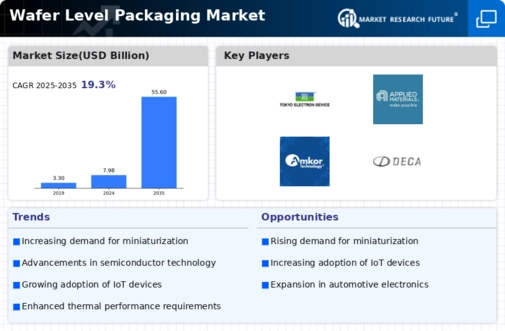Top Industry Leaders in the Wafer Level Packaging Market

The Competitive Landscape of Wafer Level Packaging Market
Within the microscopic realm of silicon chips, a silent waltz unfolds - tiny components pirouette in intricate assemblies, interconnected by the magic of Wafer Level Packaging (WLP). This dynamic market vibrates with the competitive hum of players orchestrating this high-precision performance. Understanding their strategies, the factors influencing market share, and the overall competitive scenario is crucial for navigating this complex terrain.
Key Players:
- Fujitsu
- Qualcomm Technologies, Inc.
- Tokyo Electron Ltd.
- Jiangsu Changjiang Electronics Technology Co. Ltd
- Applied Materials, Inc.
- Amkor Technology, Inc.
- Lam Research Corporation
- ASML Holding N.V
- Toshiba Corporation
- Deca Technologies
Strategies Adopted by Leaders:
- Technological Prowess: ASE Technology and Amkor Technology lead the charge with expertise in comprehensive WLP solutions encompassing wafer bumping, micro-transfer printing, and redistribution layers, catering to complex applications in mobile devices and wearables.
- Vertical Specialization: Taiwan Semiconductor Manufacturing Company (TSMC) focuses on cost-effective WLP solutions for smaller chips and specific industries like automotive electronics, while JCET Group targets niche applications like stacked memory architectures and 3D integration.
- Partnership Play: Infineon Technologies collaborates with system integrators and chip designers, offering customized WLP solutions and seamless integration with existing electronic assemblies.
- Focus on Miniaturization and Performance Enhancement: Implementing advanced materials and techniques like 3D integration and fan-out wafer-level chip-on-chip (FOWLP) enables smaller, lighter, and more powerful devices, commanding premium prices and securing market share.
- Embrace of Advanced Automation and Digitalization: Implementing intelligent factory concepts and data analytics for process optimization and yield improvement minimizes errors, reduces costs, and enhances operational efficiency.
Factors for Market Share Analysis:
- WLP Functionality and Performance: Companies offering WLP solutions with superior thermal dissipation, electrical connectivity, and reliability command premium prices and secure market share by enabling high-performance and robust electronic devices.
- Cost Competitiveness and Affordability: Balancing advanced functionalities with an attractive price point is crucial for capturing market share, particularly in price-sensitive segments like consumer electronics and emerging markets.
- Scalability and Manufacturability: High-throughput production processes and readily available raw materials contribute to cost-effectiveness and ensure consistent supply of WLP solutions, fostering market adoption.
- Integration with Advanced Chip Technologies: Seamless compatibility with next-generation semiconductors like FinFETs and emerging memory technologies positions companies for future market opportunities.
- Focus on Environmental Sustainability and Resource Efficiency: Minimizing waste and utilizing environmentally friendly materials resonates with sustainability-conscious customers and opens doors to green procurement policies.
New and Emerging Companies:
- Startups like SiTime and X-Fab: These innovators focus on developing cutting-edge WLP solutions for niche applications like MEMS devices and high-frequency circuits, aiming to revolutionize performance and miniaturization in specific markets.
- Academia and Research Labs: Stanford University's Microfluidics and Nanofluidics Laboratory and Georgia Institute of Technology's Institute for Electronics and Photonics explore disruptive technologies like roll-to-roll WLP processes and advanced microfluidic cooling systems, shaping the future of the market.
- Advanced Software and Simulation Tools: Companies like Mentor Graphics and Ansys develop computer-aided design and simulation platforms for optimizing WLP design and process parameters, accelerating innovation and reducing development costs.
Industry Developments:
Fujitsu:
- October 26, 2023: Collaborated with a leading semiconductor manufacturer to develop and implement WLP solutions for high-performance computing (HPC) applications.
- June 2023: Announced the development of a new WLP technology with enhanced thermal management capabilities for advanced processors.
Qualcomm Technologies, Inc.:
- October 25, 2023: Partnered with a major smartphone manufacturer to integrate their WLP-based power management ICs (PMICs) into the latest smartphone models.
- March 2023: Unveiled a new generation of WLP-based RF filters with improved signal integrity and higher efficiency for 5G and beyond applications.
Tokyo Electron Ltd.:
- October 20, 2023: Showcased their advanced WLP equipment and processing solutions at SEMICON Taiwan, highlighting their role in enabling high-volume production of WLP devices.
- May 2023: Secured a contract with a Chinese memory chip manufacturer to supply their WLP equipment for a new production facility.
